The New Tourist's Guide to the Milky Way - space.com
http://www.space.com/scienceastronomy/060227_mm_milky_way_tour.html
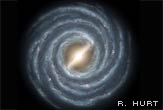 By Ker Than
By Ker ThanStaff Writer
posted: 27 February 2006
06:48 am ET
The Irish novelist George Moore once wrote, “a man travels the world in search of what he needs and returns home to find it.”
Astronomers sometimes follow a similar philosophy when they want to learn about our galactic home, the Milky Way.
Because Earth is located on the same plane as the Milky Way’s disk, astronomers can’t look down upon our galaxy to study it the way they can for others, like Andromeda. So for a long time, even basic things about the Milky Way, such as its shape and size, were difficult to determine.
 Fly Through It
Fly Through ItWATCH VIDEO
Take a quick tour through our galaxy and beyond, with stops at major attractions!
Time travel
Astronomers came up with a variety of ways to solve this problem. They invented tools that see in ways human eyes can’t, devised clever measuring techniques, and, as Moore suggested, they “travel.”
With penetrating telescopes, astronomers roam the entire universe, exploring billions of galaxies in their virtual spaceships. They take the lessons, some of them learned billions of light-years away and billions of years back in time, and apply them closer to home.
As a result, our picture of the Milky Way is constantly changing as technology improves and astronomers learn more about distant galaxies. The current picture is richer than even just a few years ago as astronomers have filled in knowledge gaps and added new details.
They’ve recently learned, for example, that the mysterious dark matter saturating our galaxy is actually “warm,” and they verified by various indirect means the existence of a supermassive black hole at its center. Studies have also shown that the Milky Way is more massive, more crowded and its stars more lonely than previously thought.
If our virtual travelers could then now fly home, approaching the Milky Way from afar and then soar to its center, here is what they would find.
Out there

The galaxy's main disc is surrounded by a halo of old stars and globular clusters (shown in red) in this rendering.
Credit: NASA
Artist's impression of the globular cluster Messier 12 and its tidal tail as it orbits our galaxy.
Credit: ESO
The Milky Way is a member of a collection of more than 50 galaxies called the Local Group. In terms of space occupied, Andromeda, or M31, is the biggest galaxy in this posse, but the Milky Way is the most massive.
Were an intergalactic traveler to approach the Milky Way edge-on, the first thing she would notice is a luminous halo made up of gas and stars enveloping the galaxy. The halo is about 100,000 light-years in diameter and 1,000 light-years thick.
A light-year is the distance light travels in a year, about 6 trillion miles (10 trillion km).
This halo contains some 170 orbiting star clusters and about a dozen small galaxies. The gravitational tug of the Milky Way is so great that it can sometimes tear these passing satellites apart, stripping them of gas and even stars. One star cluster, Messier 12, is thought to have been robbed of as many as a million stars in this way.
Orphan stars stripped from their parent galaxies and clusters form streamer-like “tidal tails” or else they linger in the galactic halo, where they intermingle with other lone stars. These other stars are mostly ancient, around 12 billion years old and older, and they don’t rotate around the galactic center in any organized way.
Orbiting satellites can also affect the shape of the Milky Way. According to one hypothesis, the strange warp in the Milky Way’s hydrogen disk is caused by the movement of two dwarf galaxies—the Large and Small Magellanic Clouds— and their interactions with dark matter as they orbit our galaxy.
Dark matter is an unknown sort of material that has never been seen. Astronomers know it permeates or galaxy and others because the collections of stars could not hold together without some other, invisible source of gravity.
Next Stop: The spiral disk
Astronomers estimate that the Milky Way contains about 100 billion stars. Recently, however, this number was upped by about a billion after the discovery that very old, nearly invisible stars had escaped earlier detections.
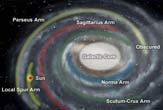
You Are Here
The Milky Way is believed to contain four major spiral arms, all of which start at the galaxy's center, plus a number of smaller arms. Our Sun is located on a spur of the Orion Arm.
Credit: NASA/JPL
Most of the Milky Way’s stars are concentrated in a main disk, which lately has been described as a series of disks, none of which are entirely distinct, but instead overlap one another. The largest is known as the thick disk; this disk is fairly flat and spirals like a slow-spinning hurricane because of our galaxy’s rotation.
Nestled within the thick disk is an even flatter disk of stars, known as the thin disk. The stars in this thin disk rotate even faster around the galactic center than those in the thick disk.
Further in is yet another disk, known as the extreme disk, where stars and clouds of gas are moving fastest of all.
Our Sun, which is 4.6 billion years old, is located 26,000 light-years away from the galactic center on one of the spiral arms. It is a location considered more suitable than others for harboring life, in part because the central region is too chaotic, and in part because the concentration of metals there is too heavy, and it’s too light in the galaxy’s outer fringes.
The Sun makes one complete orbit around the galaxy about once every 225 million years. In contrast, stars near the galactic center complete a lap in a few million years or less. These stars as a group tend to be younger than the galactic average, most ranging in age from 1 billion to 10 billion years old.
Getting closer: The galactic bar
A galactic traveler nearing the center of the Milky Way will feel a greater pull of gravity as the ship approaches the densest and brightest part of our galaxy, a spherical region known as the central bulge.
The Milky Way Bar
Rendering of the Milky Way and its central bar as it might appear from above. Arrow shows location of our Sun.
Credit: NASA/JPL-Caltech/R. Hurt
Things are much different here. Most of our galaxy is relatively uncrowded—the nearest star to our Sun, for example, is 4.2 light-years away. But roughly 10 million stars are known to orbit within a light-year of the galaxy's center.
Recent infrared surveys with NASA’s Spitzer space telescope confirmed that the Milky Way is not a perfect spiral galaxy but instead sports a long bar of stars within the central bulge. This galactic bar is believed to be made up of about 30 million stars, stretching 27,000 light-years from end to end. It consists mainly of old, red stars, which is one reason it stands out and can be detected.
The galactic bar is thought to spin like a propeller inside the Milky Way center, helping to create our galaxy’s unique spiral shape.
Observations of other galaxies also suggest that galactic bars plays an important role in feeding the colossal black holes believed to lay at the heart of many galaxies, including our own.
Destination: The black hole
The Milky Way’s suspected black hole is called Sagittarius A*, or Sgr A*, and is thought to have between 3.2 and 4 million times the mass of our Sun.
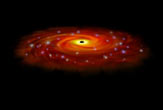
Where the Action Is
Illustration depicts what might occur very close to Sgr A*. The black hole is surrounded by a disk of gas (yellow and red). Massive stars, in blue, have formed in this disk, while small disks represent where stars are still forming.
Credit: NASA/CXC/M. Weiss
Recent studies suggest that all of this mass is confined, amazingly, to an area approximately 10 times smaller than Earth’s orbit around the Sun. Sgr A* is also probably rotating, making one full revolution about every 11 minutes.
Scientists haven’t glimpsed Sgr A* directly but they infer its distance from the incredible speeds of the stars around it, which move 50 times faster than Earth orbits the Sun. The gravity required to keep these stars in such a fast, tight orbit is calculable, and the tiny area into which it must fit indicates that it has to be a black hole, experts say.
While most black holes form from the collapse of massive stars, colossal black holes like Sgr A* are believed to have “co-evolved,” or formed along with the galaxies they inhabit.
According to this view, black holes are more than just indiscriminate and voracious gobblers of matter; they are forces of creation that help sculpt a galaxy’s shape and distribute its stars.
Our intergalactic traveler’s journey through the Milky Way ends here at Sgr A*. The ship must either swerve away and make for other galaxies, or risk breaching the black hole’s event horizon, the theoretical boundary beyond which gravity is so strong that no form of matter or energy can escape.
More to come
There are still vital details missing in our picture of the Milky Way. Current models insist, for example, that our galaxy should have as many as a thousand dwarf galaxies buzzing around it, each with between 0.01 percent to 10 percent the mass of the Milky Way. Yet only a relative few satellite galaxies and globular clusters have been found.
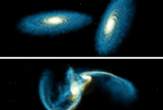
Our Messy Future
A simulation of what might happen when the Andromeda Galaxy hits ours. The central regions will collide and merge to form a single elliptical galaxy.
Credit: F. Summers/C. Mihos/L. Hemquist
One hypothesis is that these missing satellites are composed entirely of dark matter and therefore invisible to current technology.
Also, even though astronomers can predict that the Milky Way will collide with Andromeda and cease to be a spiral galaxy in about three billion years, our galaxy’s origins is a story that remains largely untold.
According to the best recent theories, the Milky Way and other large galaxies like it grew through a combination of mergers between small hot clouds of intergalactic matter and, over time, galactic cannibalism.
Like many of the details about our Milky Way uncovered so far, the answer to this mystery will probably be found far from home as well, in young galaxies that are still forming and in distant ones where scientists have found new features thought to be important for galaxy formation and star births.
This article is part of SPACE.com's weekly Mystery Monday series.
SPACE.com Videos:
When Stars Collide
Fly Through the Milky Way and Beyond
Black Hole: Warping Time & Space
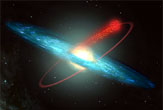


0 Comments:
Post a Comment
<< Home